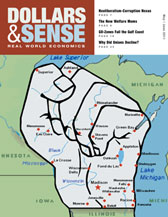This article is from Dollars & Sense: Real World Economics, available at http://www.dollarsandsense.org

This is a web-only article, available only at dollarsandsense.org.
Subscribe Now
at a 30% discount.
Making Sense
From Public Meat Markets to Derivatives Markets
A Lesson from Old New York
Starting in the colonial era, New York, Boston and Philadelphia required all fresh meat to be sold by licensed butchers in regulated public markets. New York abandoned public markets in the 1840’s, with disastrous effects on public health. A working paper by economic historian Gergely Baics lays out the story.

Travel back in time to 1811, the year the Commissioners’ Plan lays out the street grid for Manhattan. Since 1790, New York City population has tripled to 96,000; housing now straggles north as far as Christopher Street on the west side.
On a cold and rainy night in April, a cattle drover holds up his lantern and taps his stick on the backsides of six muddy steers. Mooing in the dark, the steers stumble from the Brooklyn Ferry on the East River, up Catherine Street, and across Division Street. The stench grows as they enter the slaughterhouse district near Collect Pond. By lamplight, blood-spattered workers hack up the animals, distributing the parts to waiting butchers, tanners, bone-boilers, soap-makers and tallow chandlers. Raw leftovers will be dumped in the river. The butchers wheel away slabs of beef to their stalls at the Fly Market. The Fly, occupying three blocks of Maiden Lane between South Street and Pearl Street, is the largest of nine public markets established by the New York City Council. In the gray dawn before 6 AM, the butchers open for business. There’s no refrigeration; most of the meat will be gone by 10 AM. The first customers are men and servants from the wealthiest households. They buy the choicest cuts, at the highest prices. Over the hours, prices and quality fall. At 2 PM closing, butchers scrub their cutting blocks in a swirl of flies, while a few poor women hurry down the street looking for bargains. In the course of a year, New Yorkers will consume some 160 pounds of fresh red meat per capita, close to modern levels.
The City Council forbids private butcher shops. As the city grows, it establishes public spaces in easy walking distance of residents. Here, highly-skilled, city-licensed butchers operate from small stalls, paying fees to the city. City inspectors patrol for unsanitary conditions, mystery meat, or thumbs on scales. Customers comparison shop, keeping prices and quality competitive. The butchers also watch one another, reporting violations and creating peer pressure to maintain high standards. Butchers often keep the same stall for years, building trust with regular customers.
In short, the markets operate much like the ideal competitive markets we meet in Economics 1: many responsible sellers of standard products in a stable relationship with many well-informed buyers, meeting in a single physical location.
But things change in the 1830’s. As population explodes—reaching 800,000 by 1860—the City Council fails to plan new markets or control illegal meat vendors. It stops maintaining the existing markets, which become dilapidated and filthy. In 1843, it legalizes private shops, and fully abandons public markets in 1848. Only a handful of inspectors remain to police hundreds of widely-dispersed private butcher shops. Health consequences are dire. Per capita fresh meat consumption falls, as does average adult height—indicating poorer nutrition. The death rate from diarrheal diseases triples.
So why does the city abandon a successful policy? The cholera outbreak of 1832, and the Great Fire of 1835, impel the city to build the Croton Aqueduct, completed in 1842, bringing abundant clean water 41 miles from Westchester County. To pay the huge construction debts, the city diverts fees from the meat markets. The panic of 1837 and ensuing depression further cripple city finances.
What’s the lesson for derivatives markets?
Public securities exchanges, such as stocks and bonds, corn futures, or gold, operate on the same principles as public produce markets. Be it contracts or sirloins, licensed professionals trade standardized products on designated exchanges, according to rules meant to curb fraud and monopoly. Since the 1792 founding of the original stock exchange, new financial products have been brought onto regulated public exchanges—typically following a scandal. In 1998, a new private market sprang up in “derivatives,” such as credit default swaps. Brooksley Born, chair of the Commodity Futures Trading Commission, proposed that the commission be given oversight—only to run afoul of the free-market trio of Alan Greenspan, Larry Summers, and Robert Rubin. The private derivatives markets mushroomed from $100 trillion to $700 trillion before blowing up in 2008.
Lesson learned again: “free” markets require government oversight to operate safely and fairly. The 2010 Dodd-Frank Act will require derivatives to trade on regulated public exchanges. But a loophole allows the Treasury Secretary to exempt some derivatives. On April 29, the Financial Times reported a “Victory for dealers and defeat for reformers”—Secretary Timothy Geithner exempted over-the-counter foreign exchange swaps.
Meanwhile, public produce markets have returned to New York in the form of Greenmarkets. Natural and spontaneous though these markets appear, their annual report makes clear they’re licensed, inspected, and regulated just like the old meat markets.
Did you find this article useful? Please consider supporting our work by donating or subscribing.
